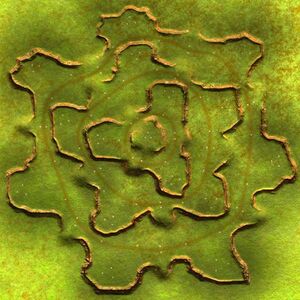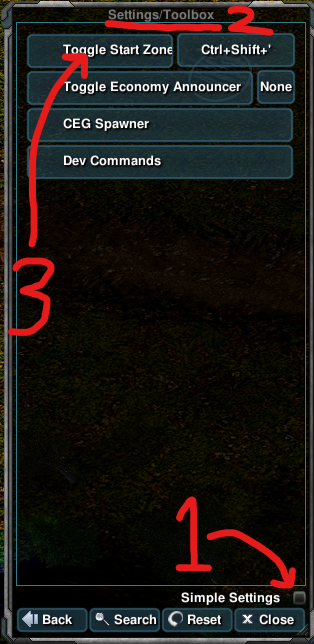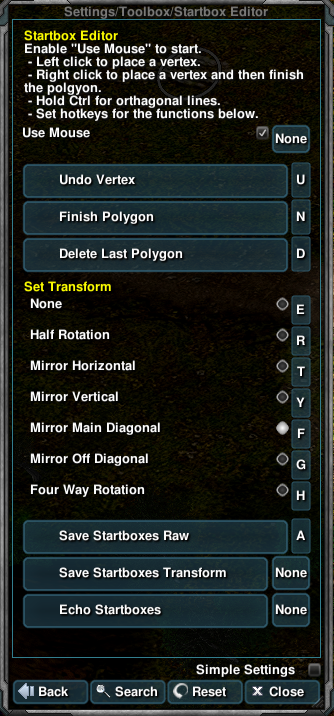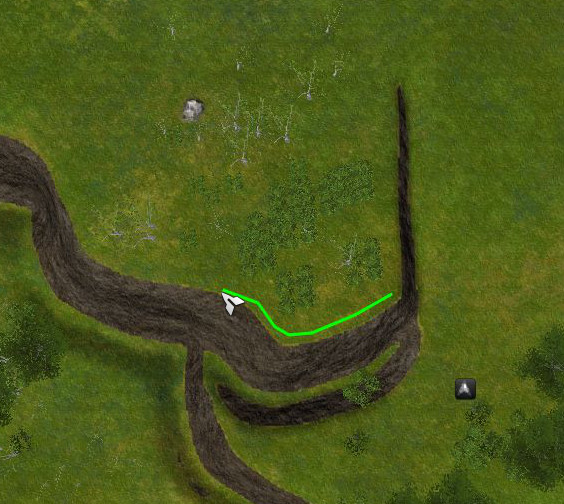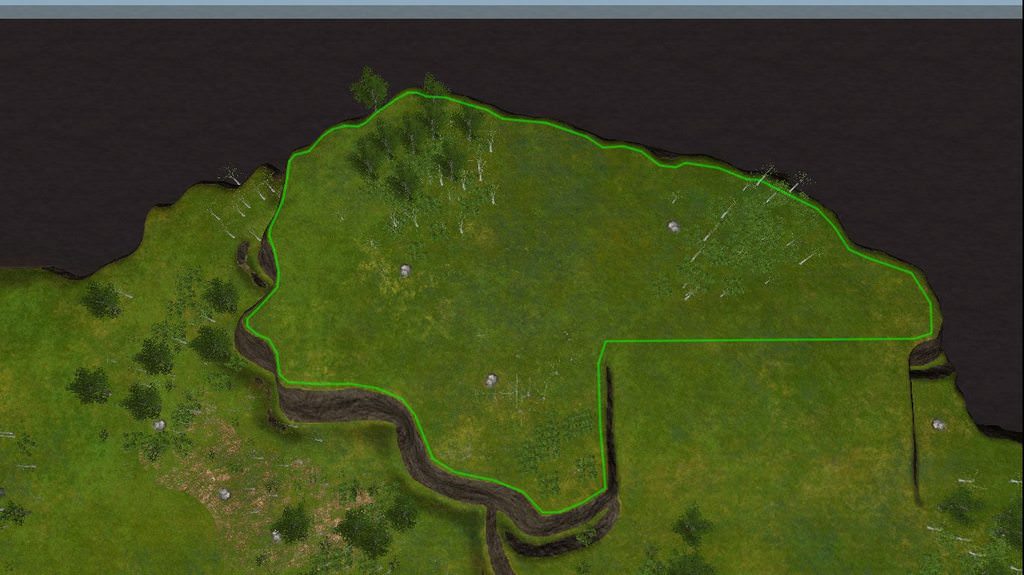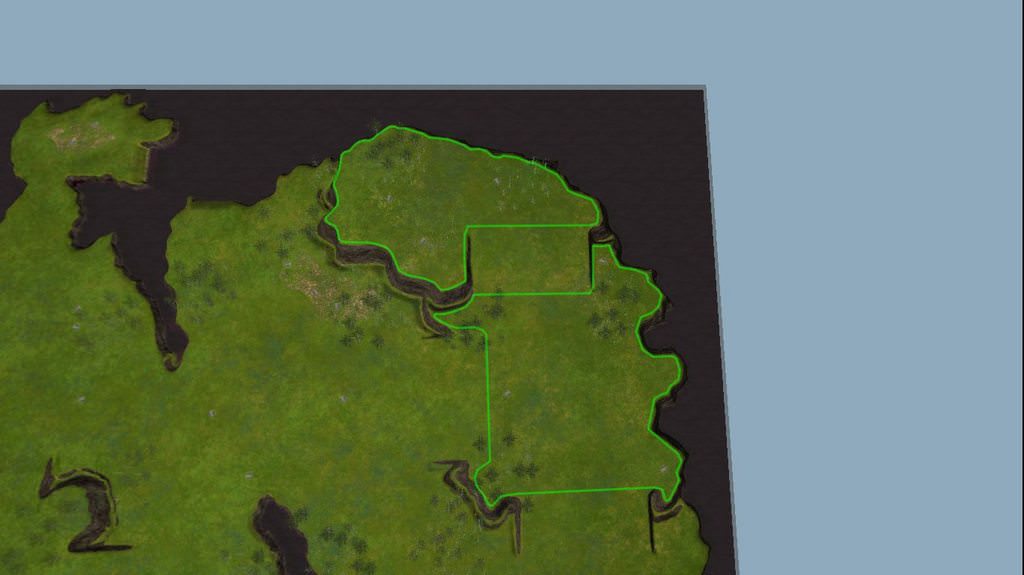Startbox API
Contents
Start boxes[edit]
Each team has a defined starting area in which its players can spawn their commanders—these are called start boxes. Map makers can define how these areas look by including a configuration file inside their map archive.
The config file[edit]
The file that you need to include is
mapconfig/map_startboxes.lua
It consists of Lua code which returns 2 tables: one with the start box layout for the current match and one that contains possible box counts.
For examples see the bottom of this page.
Box counts[edit]
Let's start from the last table because it is the simplest. This is just a list of how many teams the map is designed for.
Let's take Throne map as an example. It has an outer ring with 7 starting areas, so it can be played as a 7-team FFA. There are also rings with 3 and 5 areas so 3- and 5-team FFAs are also possible setups. Finally, you could play a duel between any two positions from the same ring. (The real Throne config is a fair bit more complicated than that, but you get the idea.)
Thus, the possible team counts are 2, 3, 5, and 7. Let's define a Lua table for that:
local playercounts = {2, 3, 5, 7}
This is mostly important for fancy FFA maps. Simple duel/teamgame maps will usually just have 2 as the only value here:
local playercounts = {2}
The widget[edit]
Load your map in ZK, open the ingame menu (F10), untick "Simple Settings" at the bottom, and navigate to "Settings/Toolbox". Click "Toggle Start Zone Editor", this should cause a new submenu to appear. Navigate to "Settings/Toolbox/Startbox Editor" then click "Use Mouse" to enable startbox editing. The startbox editor submenu contains instructions and the buttons have tooltips. The buttons can be clicked or have hotkeys set, like any other menu button, some suggested hotkeys are below.
The boxes[edit]
Now, the most tedious part. The boxes do not need to actually be boxes, they can be any arbitrary shape (even concave or disjoint). This is achieved by having the boxes defined as a set of polygons.
To draw a polygon using the left mouse button—either drag a line or click points:
Once you draw a full loop, press the right mouse button to close it. Make sure the line does not cross itself. Finished polygons are a bit darker.
Now you can add another polygon if you want. These will all be a part of the same team.
If you want to delete the last created polygon, press D. Once you are satisfied with the area, press S. Now you can draw the area for another team.
Once you create all the boxes, go to your Spring directory and find the infolog. There you will see a bunch of code like
boxes = {
stuff
},
Each of those tables is a team's start box. The config is an array of each team's start box data. The box data from the generator will go to a team's config entry. Like this:
local main_config = {
{
boxes = {
stuff
},
-- more entries will go there later!
},
-- another team's box data
{
boxes = {
stuff
},
},
}
The layout is a normal Lua table so you can use all the usual table manipulation methods. For example, you could add more areas based on how many people there are, or generate them dynamically.
The recommended start points[edit]
This sub-table defines recommended start points within each box. These are points on which CAI bots will spawn. The first point is special: human players who did not pick start position will also spawn here and so will any extra CAI if there are more of them than the spots; as such having at least one start point in each box is mandatory. These points are also marked on people's UI as circles.
Defining these is very simple. It's very similar to how start areas were defined. In game, you can hold Space over a point to see its coordinates. These are written down for boxes similarly to the areas:
local main_config = {
{
boxes = {
stuff
},
startpoints = {
{123, 456}, -- X, Z
{654, 321},
-- as many as you want, it's good if there are as many as you want people per team
},
},
{
boxes = {
stuff
},
startpoints = {
{789, 789},
{987, 987},
},
},
}
Of course, the start positions should match the areas, though they don't have to.
Team names[edit]
You can give each team a name, alongside a shorter backup if the first one is too large. Here's how:
{
boxes = { stuff },
startpoints = { stuff },
nameLong = "Southwest",
nameShort = "SW",
}
It serves to identify the team, so while it's good to use something that describes placement, you can get creative. For example:
- "North", "Southeast"
- "5 o'clock"
- real-world style maps could have names like "Russia" or "America"
- asymmetric maps can use landmarks, for example "Lake" vs "Desert"
- for missions, it's good to use storyline names, e.g. "Empire" vs "Dynasty"
Summary[edit]
Now just return the config table and the playercounts table.
return main_config, playercounts
The exact format for the config table that should get returned is
{
{ -- a single team's data
boxes = {
{ -- a polygon
{123, 456}, -- a vertex of the polygon. X, Z.
{234, 567}, -- another vertex
{345, 678},
-- more vertices
},
{ -- another polygon
-- vertices
},
-- more polygons
},
startpoints = {
{123, 456}, -- X, Z
{654, 321},
-- more points
},
nameLong = "longer string with team name",
nameShort = "short",
},
{ -- another team's data
boxes = { ... },
startpoints = { ... },
nameLong = "...",
nameShort = "...",
},
-- more teams
}
Advanced stuff[edit]
The config has access to Spring Lua API, so it is possible to do a lot of dynamic things. In particular, you can use math.random without worry.
You can make stuff dependent on the game mode. There are functions which return the game type, such as "Spring.Utilities.Gametype.is1v1()".
An important thing is that #Spring.GetAllTeams() will return a wrong value due to fake technical teams and Gaia. Instead, use Spring.Utilities.GetTeamCount() to get the real number of teams.
Examples[edit]
- SpeedMetal - the simplest layout, just two squares.
- DSD - huge polygons, but otherwise very simple.
- Sever - shows an example of smaller boxes for 1v1 and larger for teams.
- Isle of Grief - shows a smart approach, one of the boxes is not defined rigidly but is a mirror of the other (only really feasible for rough boxes or perfectly symmetrical maps).
- Aum - another small trick, this time 5-way radial symmetry.
- Throne - multiple boxes defined, with a system to pick some of them based on how many teams there are.
- Speedball - shows boxes that are generated completely algorithmically.
- Middle-Earth - interesting team names.
- Adansonia v2 - shows synchronizing boxes across map versions.
- Duck - boxless config for silly maps where everybody can start anywhere.
